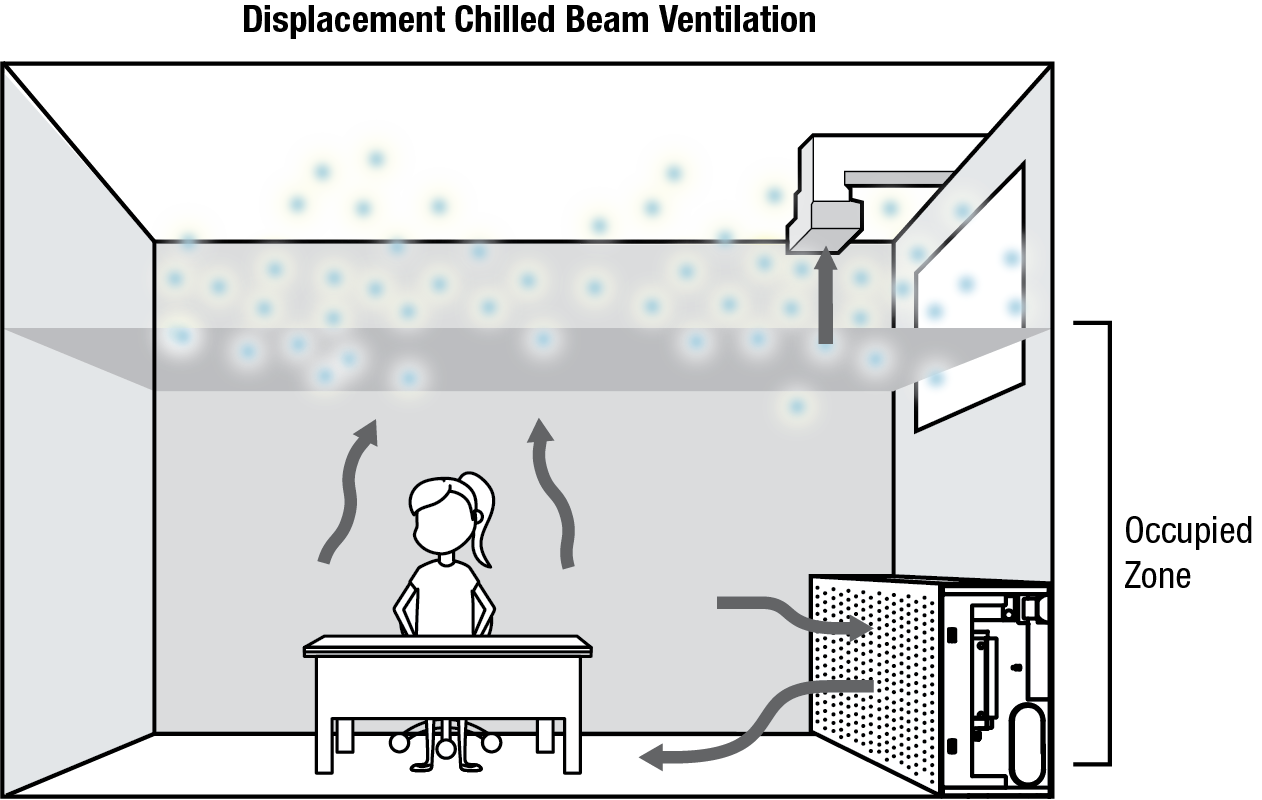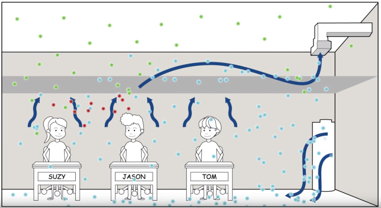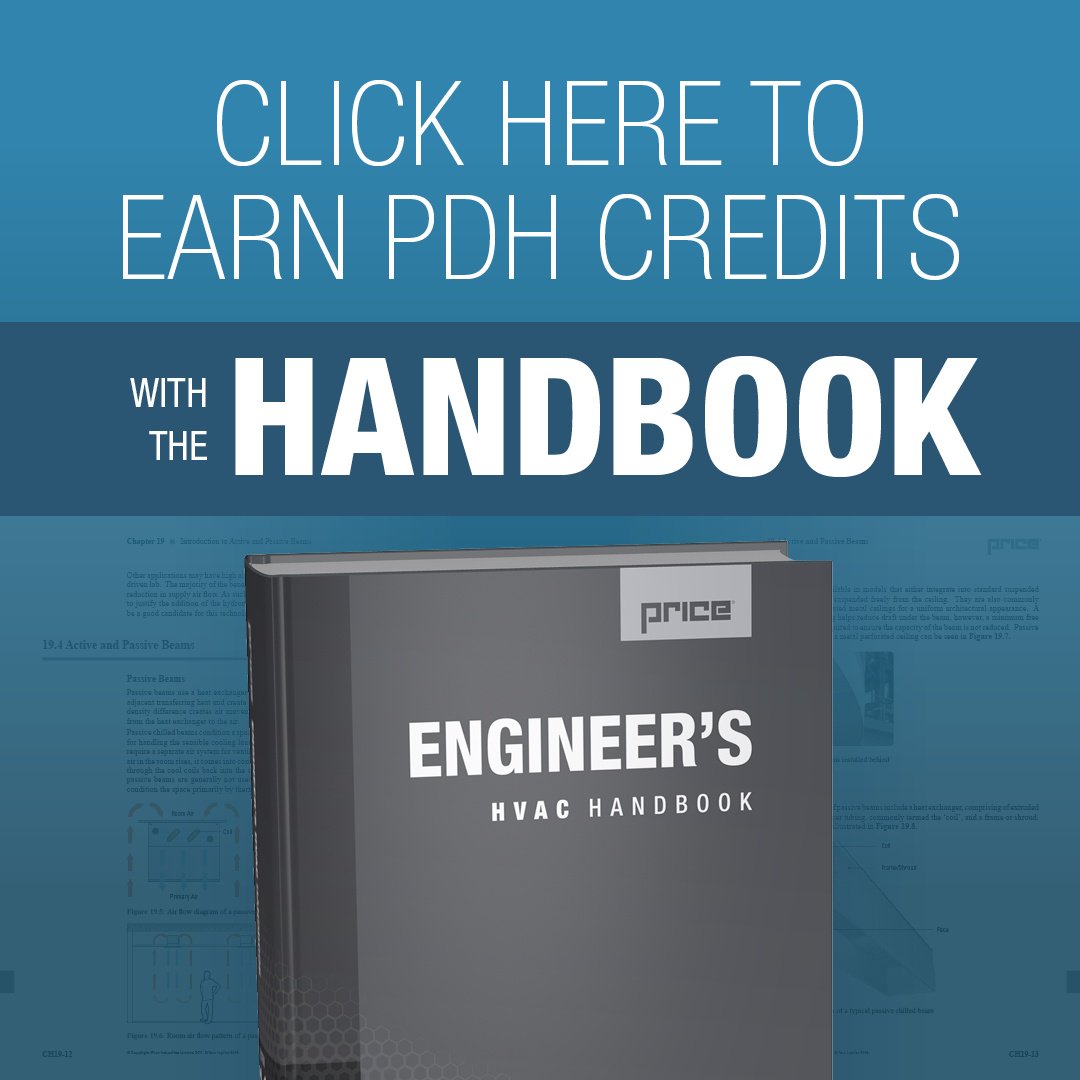The Benefits of Displacement Ventilation and Chilled Beams for Efficiency
The United States Environmental Protection Agency (EPA) defines a high performance school as energy and resource efficient. Creating a high performance school is not difficult, but it requires an integrated, “whole building” approach from the beginning of the design process.

Even a modest investment in school building performance can yield significant benefits and cost savings, such as:
- Improving health and comfort to enhance student learning
- Increasing average daily attendance
- Reducing utility bills
- Taking advantage of incentive programs
Displacement Ventilation
Displacement ventilation is an energy efficient method of air delivery that supplies air directly into the occupied portion of the space at low air speeds. Air quality and occupant satisfaction is improved due to the manner in which the air distributes throughout the space.

Overhead air distribution (left) versus Displacement Ventilation (right)
Displacement Chilled Beams
There is an increasing need for energy efficient air conditioning systems as energy codes become more stringent. Displacement chilled beams allows engineers to combine the benefits of both chilled beam and displacement technologies.

Combination of displacement and beam technology
Watch this video and continue below to see how Displacement Ventilation and Beams can improve energy and resource efficiency in school environments.
High Indoor Air Quality
Indoor environmental quality (IAQ) has been proven by several independent studies to have a major impact on health, performance and attendance of students and teachers. Displacement ventilation has shown significant improvements of the air quality in classrooms on a number of studies conducted.11,12,13,14
The image below shows provides an illustration of what happens when particulate, such as that from a child sneezing, enters the space. In a mixing space, the particles released in a sneeze would be mixed throughout the space. In a displacement system, the particles are pushed upward, and out of the breathing zone.
 In a mixing system, the sneeze particles (red) are mixed throughout the space.
In a mixing system, the sneeze particles (red) are mixed throughout the space.

In a displacement system, the sneeze particles (red) are pushed up and out of the breathing zone.
Improved Thermal Comfort
Displacement Ventilation supplies at low velocity with warmer air and is driven naturally by the heat sources and occupants throughout the space, providing superior comfort.
Some traditional systems can lead to uncomfortable thermal conditions. If a unit ventilator is being considered for a classroom it is important to note that these products can experience infiltration issues over time. The leakage can be very difficult and costly for schools to fix, and it can cause significant comfort and air quality issues in the classroom.
Low Maintenance
With limited operating budgets, schools can save by installing a displacement system. A recent study found that schools should be spending $145 billion annually to keep up with facilities, right now they are only spending $99 billion.6 When systems aren’t cared for they start to break down resulting in more serious issues affecting maintenance costs and air quality.
Due to the reduction in moving parts and mechanical equipment (fans, filters, drain pans, and condensate pumps) found in beams and displacement units, these systems typically have lower maintenance costs compared to other systems.
Low Operating Costs
The nationally recognized ventilation standard, ASHRAE 62.1, allows for a reduction in outside air volume (up to 33%) to condition a space due to the improved air quality a displacement system generates.9 The ability to reduce the amount of outside air required can significantly impact annual energy savings.
- Lower fan power requirement, because air is driven naturally upwards by occupants.
- Warmer supply air temperature can require less cooling load on equipment.
- Less expense to cool. Use outdoor air up to 65°F to cool the space.
Lower Noise Levels
Lowering background noise levels can help reduce the impact on con-centration levels of both teachers and students. In 2012, ANSI introduced a new standard for classroom noise levels, S12.60. This standard states that background noise levels in all core learning areas should not exceed 35 dBA (N27).
Experience has shown that in practice these sound level targets are not being met. The results from a recent study found that only 1 out of 54 classrooms met the <35dBA target.10 A major contributor as to why classrooms failed to meet the standard were the installed HVAC systems.
Life Cycle Costs
The versatility of a chilled beam and displacement system allows you to design for every budget. Initial costs can be controlled through the proper selection of components, the implementation of technology, a well engineered control strategy, and a competitive bid process. Various climatic regions have adopted displacement ventilation as the standard in classroom design and noted that these systems have a comparable first cost to other commonly used HVAC systems.
Displacement ventilation can lead to improved student performance and attendance which is directly related to government funding levels in many areas. Many US states receive around $8,000 for yearly funding per average daily attendance. For example, California received $7,300 - $8,940 per average daily attendance depending on grade level in 2017-2018.19
Consider Displacement Ventilation and Beams for your next school project! For more information, contact beams@priceindustries.com.
References:
1, 2 United States Environmental Protection Agency. (2018, December 21). Designing and Constructing High Performance Schools for a Healthy School Environment. Retrieved from United States Environmental Protection Agency: https://www.epa.gov/schools-healthy-buildings/designing-and-constructing-high-performance-schools-healthy-school
3 International Well Building Institute. (n.d.). Retrieved from International Well Building Institute: https://www.wellcertified.com/en
4 Collaborative for High Performance Schools. (n.d.). Retrieved from Collaborative for High Performance Schools: https://chps.net/
5 U.S. Green Building Council. (n.d.). Retrieved from U.S. Green Building Council: https://new.usgbc.org/
6 Camera, L. (2018, January 31). Will Trump Help Rebuild America’s Schools? Retrieved from U.S. News: https://www.usnews.com/news/the-report/articles/2018-01-31/infrastructure-spending-for-schools-if-history-repeats-itself-no
7 United States Environmental Protection Agency. (2019, March 11). Creating Healthy Indoor Air Quality in Schools. Retrieved from United States Environmental Protection Agency: https://www.epa.gov/iaq-schools
8 Trane. (2017, February). Installation, Operation, and Maintenance. Retrieved from Trane: https://www.trane.com/content/dam/Trane/Commercial/global/products-systems/equipment/ductless/variable-refrigerant-volume/VRF-SVX26D-EN_02012017.pdf
9, 11 ASHRAE. (2013). ANSI/ASHRAE Standard 62.1-2013: Ventilation for Acceptable Indoor Air Quality. ASHRAE.
10 ATS&R, Kvernstoen, Ronnholm & Associates Inc. (2007). Classroom Acoustical Study. Air Conditioning and Refrigeration Institute (ARI).
12 Arent, J., Eley, C., & Meister, B. (2006). Displacement Ventilation in Action: Performance Monitoring of Demonstration Classrooms. ACEE Summer Study on Energy Efficiency in Buildings.
13 Smedje, G., & Norback, D. (2000). New Ventilation Systems at Select Schools in Sweden - Effects on Asthma and Exposure.
14 Jung, A., and M. Zeller, 2005. Analysis and Testing of Methods to Determine Indoor Air Quality and Air Change Effectiveness. Original technical paper from Rheinisch-Westfälische Technical University of Aachen, Germany, 1994.
15 Allen, J. G., & al., e. (2015). Associations of Cognitive Function Scores with CO2, Ventilation and VOC Exposures in Office Workers; A Controlled Exposure Study of Green and Conventional Office Environments. Environmental Health Perspectives 124.6.
16 Shendell, D., Prill, R., Fisk, W., Apte, M., Blake, D., & Faulkner, D. (2004). Associations Between Classroom CO2 Concentrations and Student Attendance in Washington and Idaho. Indoor Air.
17 Loftness, V., Hartkopf, V., & Khee Poh, L. (2006). Sustainability and Health are Integral Goals for the Built Environment. Healthy Buildings. Lisbon: Healthy Buildings.
18 Kim, C. S., Lim, Y. W., Yang, J. Y., Hong, C. S., and Shin, D. C., (2002) Effect of Indoor CO2 concentrations on Wheezing Attacks in Children. Indoor Air ‘02: Proceedings of the 9th International Conference on Indoor Air Quality and Climate.
19 California Department of Education. (2019, February 20). Funding Rates and Information, Fiscal year 2017-18. Retrieved from California Department of Education: https://www.cde.ca.gov/fg/aa/pa/pa1718rates.asp#absencerate



